Lloyd Triestino Trio of Liners; M.S. Australia, Oceania & Neptunia - 1950/51
Please
Note: Firefox,
iPhones,
iPads & some other Search Engines
may not be suitable
Use
Internet Explorer & Google for this Web Page to load perfectly!

Click
the logo above to reach the ssMaritime FrontPage for Ships of the Month &
News Updates
With
Reuben
Goossens
Maritime
Historian, Cruise‘n’Ship Reviewer, Author & Lecturer
Please
Note: All ssmaritime as well as my other related
maritime & cruise sites are 100% non-commercial and privately owned sites.
Be assured that I am NOT associated with any shipping or cruise companies or
agencies or any other organisations! The author has been in the passenger
shipping industry since May 1960, but although retired and unwell, I
occasionally attempt to write an article now and then, in order to bring
enjoyment and pleasure to ship enthusiasts past passengers and crew.
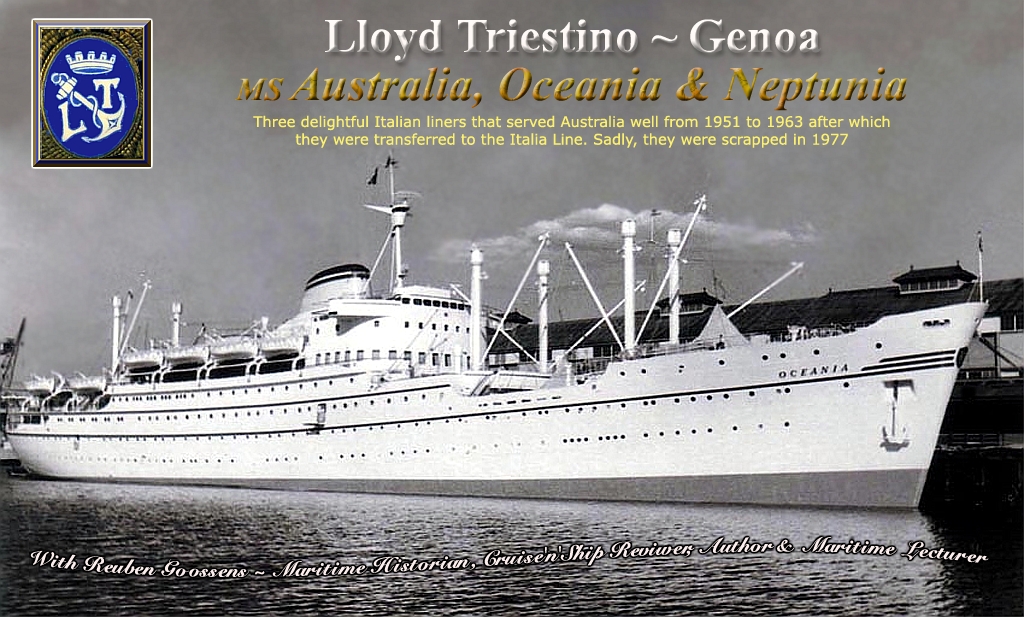
PLEASE
NOTE: Most images on this page, except those marked
otherwise, are from the author’s private collection
Including
promotional images from some excellent brochures in my possession!
Introduction:
Lloyd
Triestino Lines re-established their Australian services with a 1924 German
built ship the SS Saarbrucken that had been obtained by them in 1937 and had
been renamed the Toscana. Although having operated on various services the
9,429 GRT (Gross Registered Tons) SS
Toscana
commenced a new career as she departed Genoa
on October 19, 1948 for her very first voyage to Australia,
arriving in Melbourne
on November 30, and Sydney
on December 2.
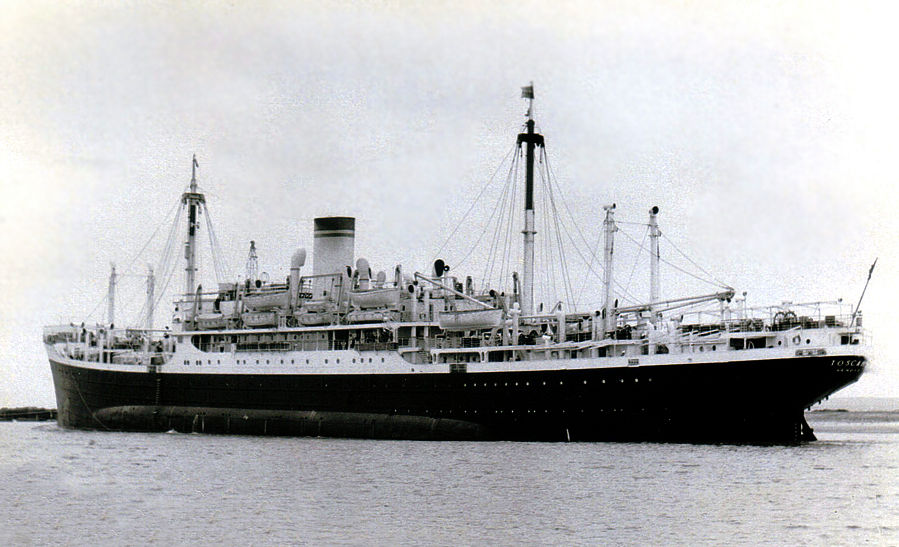
SS Toscana seen on her way to Australia
However,
Lloyd Triestino realised that they required new and modern ships on the popular
service to Australia as the migrant and the tourist passenger service, as well
as transporting cargo was in need for superior ships! Thus they had their
designers busy with plans that would eventually realise some seven ordered
excellent and almost identical looking ships! Being extremely happy with the
design and functionality of their larger Australian ships, and the slightly
smaller four ships, they signed the contracts with the builders for their Australia
class trio being their very first post war newly built liners!
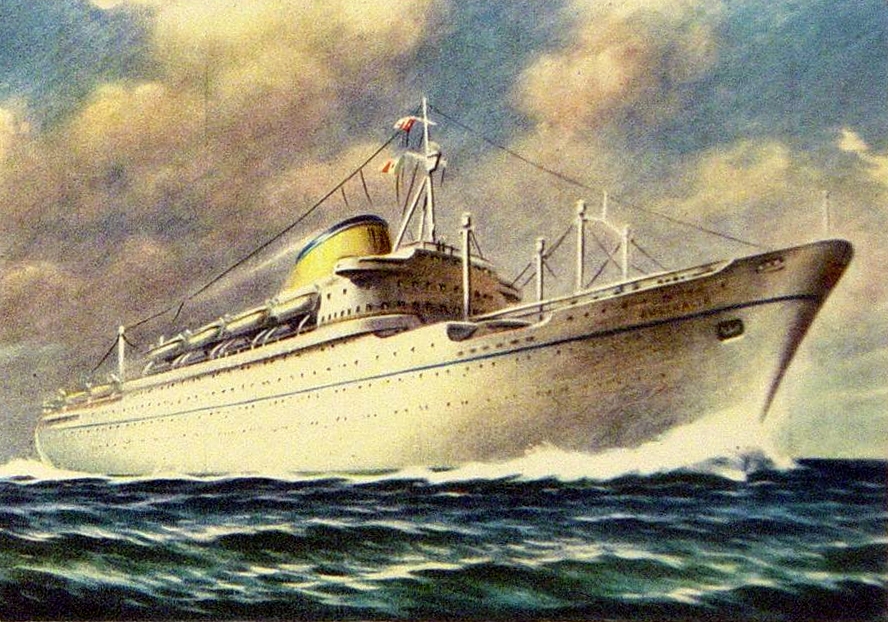
The
very first artist impression how the new MS Australia trio would look like
********************************************
Part
One – The Australia
Class Trio:
The new Lloyd
Triestino
ships were launched in the following order and we also see their GRT - Gross
Registered Tonnage and their proposed services:
1. Australia: May 21, 1950 – 12,839 GRT - Australia
service.
2. Oceania: July 30, 1950
– 12,839 GRT - Australia
service.
3. Neptunia: October 1,
1951 – 12,838 GRT - Australia
service.
These
were followed by four the slightly smaller Liners …
Africa - January 24, 1951 – 11,427 GRT – Far East
service.
Victoria - September 18, 1951 – 11,695 GRT – Far East
service.
Europa - October 21, 1951 – 11,430 GRT
– East & South Africa service.
Asia
- October 28, 1951 – 11,693
– East & South Africa service.
MS Australia and her two sisters looked as
modern as tomorrow with their gleaming white hulls and superstructure, beautifully
set off by a blue ribbon just below Upper Deck and located at the bow being the
company’s logo! Their short but shapely and stylised funnel were yellow
and topped with a blue hat with a single thin blue stripe close to the top,
being the traditional Lloyd Triestino colours. Being Cargo Passenger liners,
they had three holds forward and two aft, which were serviced by four white
kingposts with the relevant derricks forward, but just two kingposts and
derricks aft.
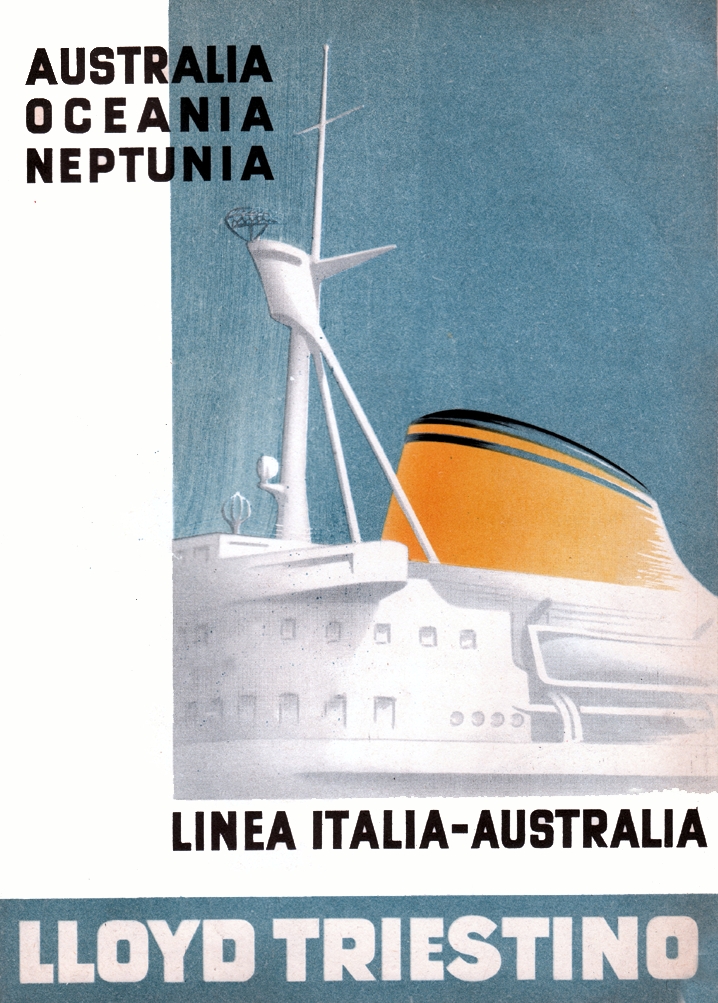
The
front cover of a booklet I own full of B&W interior photographs seen on
this page
It
was published in 1951 – The deck plan I have is also from this publication
I
have added a small additional plan showing the new Tourist Class lounge
Atop,
but slightly set back of the bridge, was a tripod style radar mast with a
traditional lookout (as you can see from the booklet above). The mast did not
just look attractive but it suited these ships perfectly! Thus the overall
impression being when anyone saw one of these delightful Italian liners was
always one of pure delight.
I recall, when one sailed up the
Sydney harbour and we first saw that beautiful shapely curved white bow and
then her perfect balance in design, with that superstructure set not forward or
even amidships, but just slightly back, that gave the appearance that they had
such long bows, thus a far more stylistic and fast appearance. And as she passed
the picture was completed by that delightful stern. But sadly, such a wonderful
sights we will never ever see again, but the memories will last forever, and it
is my intention to keep them alive with these pages!
I always felt that these Passenger Cargo liners
were close to the best designed and balanced ships of their time. However,
there are two other ships I know that would just beat them, and they are the
superbly stylish and long lasting ships that became lovingly known in Australia
as the “Elegant White Yachts” the MS Tjiluwah
and Tjiwangi of the Royal Interocean
Lines. However, that takes nothing away from the delightful lines of the Australia
trio!
However, the exterior had nothing on what the
interiors offered for that is what would make this trio popular so rapidly!
Part Two – MS Australia:
The Australia was launched by her builders Cantieri Reuniti dell’Adriatico
Shipyards at Yard number 1758, on May 21, 1950 with a great number of
dignitaries present, from Lloyd Triestino, the government and many from high
other high ranking families, for obviously this was a big event for the
company, being the very first Italian liner built specially for Lloyd Triestino
after the WWII!
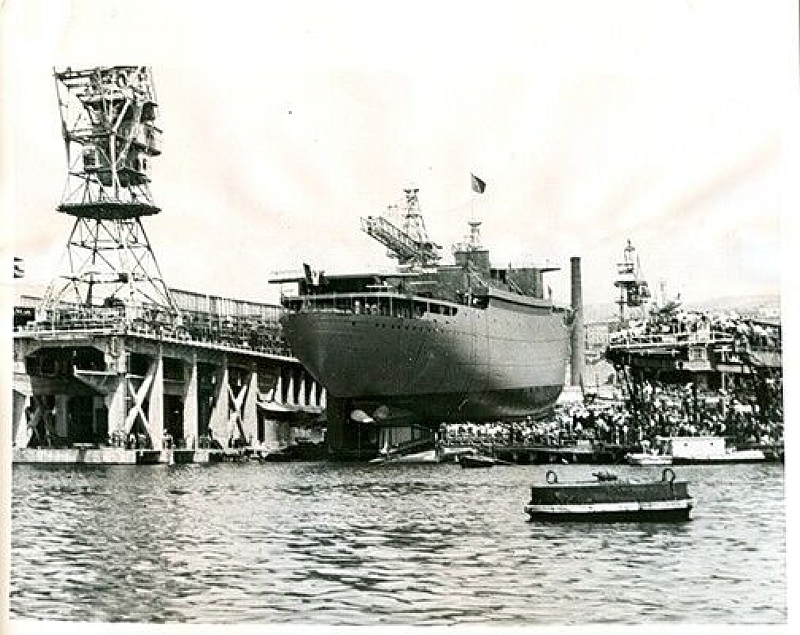
There
are big crowds awaiting the Australia
to come down the slipway!
Although
the MS Australia was the first of the trio to be completed in April 1951, she
was followed rapidly by Oceania
just a month later, but we will come to her later!
With the first of their post war
liners ready, Lloyd Triestino’s MS Australia
departed on her maiden voyage from Trieste bound for Sydney Australia on April
19, 1951, and she arrived in Fremantle (Perth) on May 11, then continued to
Adelaide arriving on May 15, she then arrived in Melbourne on May 17, where she
remained there for three days and departed on the 19th.arriving
in Sydney on May 22, but just this time she continued to Brisbane sailing along
the Brisbane river to the Hamilton wharves on May 24 where she ended her
successful maiden voyage. She returned to Italy,
not to Trieste,
but to her home port Genoa
and she would based here on depart from there!
Her and her sister’s itinerary in
general was as follows: Genoa,
Naples,
Messina,
Port Said,
Suez,
Colombo,
Djakarta, Fremantle, Adelaide,
Melbourne,
Sydney,
Melbourne,
Adelaide,
Fremantle, Djakarta,
Singapore,
Colombo,
Cochin,
Aden,
Suez,
Port Said,
Messina,
Naples
to Genoa.
There were changes later, but that was her original schedule.
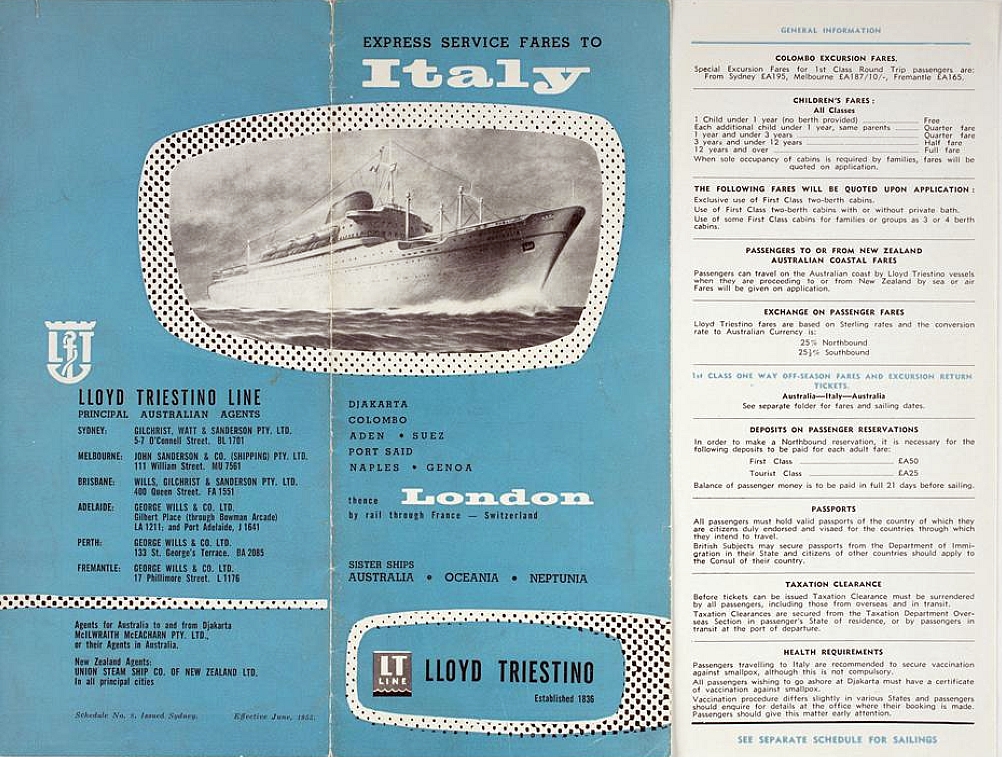
Above
& below: An information leaflet given to
passengers prior to departure. Issued in 1952
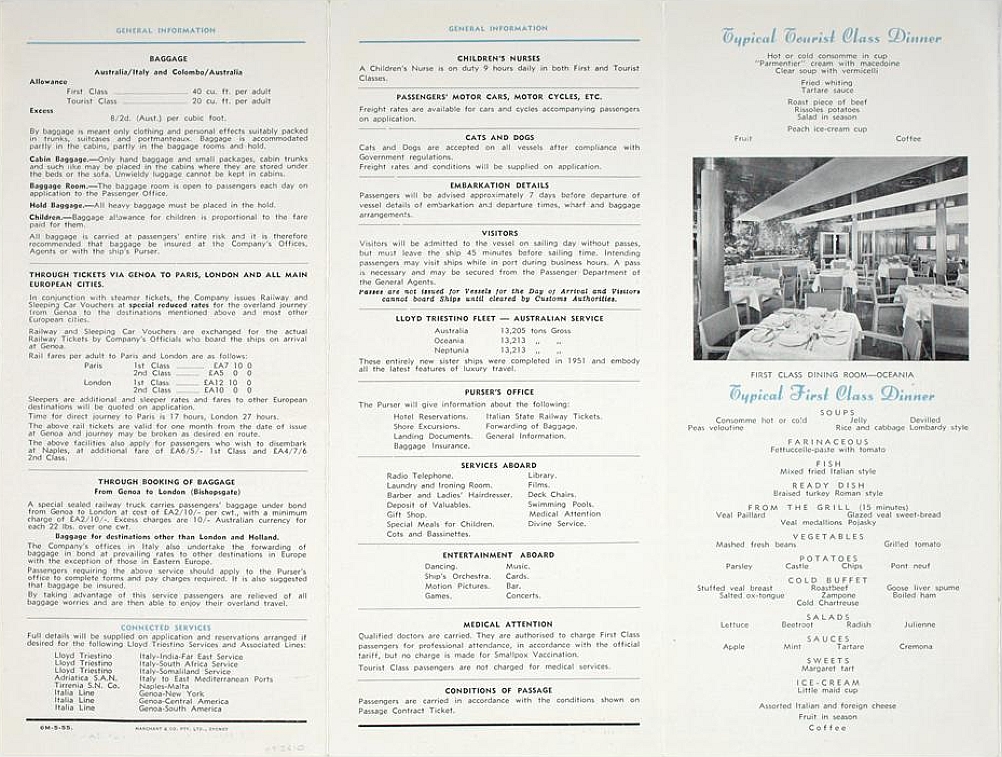
MS
Australia proved to be very successful as would be her two sisters, for these
modern and reliable ships were much needed and the company was able to once
again provide a regular schedule of modern liners on the Australia
service.
Let us now look at the First Class
facilities:
Please
Note: The layout was identical for all three ships,
the only difference being was the décor on each ship and I will be showing the
relevant images I have available for each ship under their own history and
photo album.
I will commence topside on Bridge deck
where there was ample space for sports beside and aft of the funnel.
Heading a deck down, Sun Deck far
forward located on port side was the only internal passenger venue, the ever
popular Card and Games Room and just aft of the Children’s Room, which
was well insulated I have been advised! There was nothing between this the delightful
Veranda Bar, which was fully covered and at the sides enclosed with large
windows providing a great view of the ocean, but it was open aft, thus overlooking the pool and the Tourist Class
Games Deck. This area had ample table and chairs and was a popular spot day and
night. Surrounding the pool there were ample deckchairs for those who desired
to soak up the sun!
Next was Promenade Deck, which featured
a wonderful promenade for walking, although it was not a complete walk-around,
but at least a 90% one! Inside located far forward was the only First Class
venue the magnificently appointed Main Lounge, and it has some entrance
considering it had a ship wide glass wall and doors from the lobby. In those
days vinyl flooring had become the rage, and the same applied here. The Lounge
has a round dance floor with a band stand and seating was pleasantly arranged.
On the Starboard side of the lounge going aft, thus running beside the lobby,
was the intimate and beautifully decorated Bar.
Overall this venue made quite an impression as you arrived. Although each ship
had the identical layout, but were they were blessed with their own décor. Just
aft on the port side was the Radio Room (station).
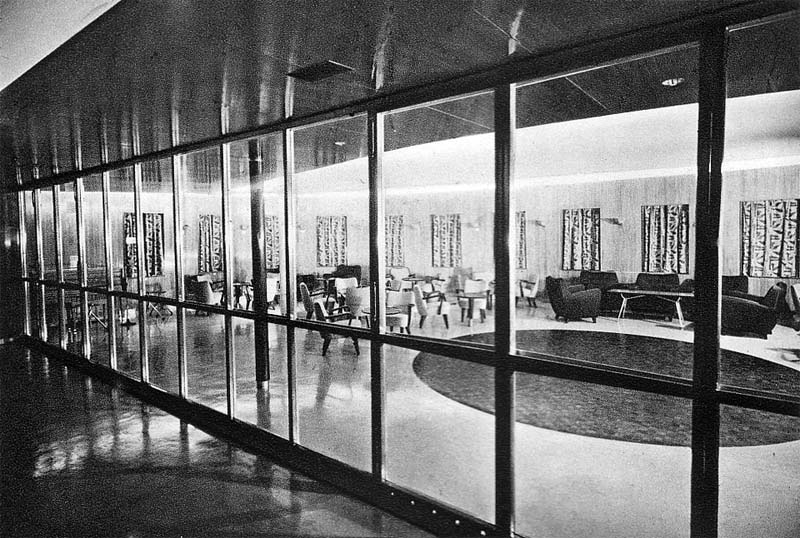
The
Main Lounge seen from the lobby
The
next deck down was Upper Deck and for the first time we have reached the
First Class accommodations.
First Class Accommodation
details: Many cabins have either just two lower
beds, or two lower beds and one or two upper foldaway berths, thus these cabins
can be sold as a twin, three, or a four berth cabin. A special feature in First
Class cabins on Upper and A decks is that one of the lower beds is a
comfortable settee, that fold down and becomes a proper bed at night. But
during the day, the room takes on the feel of a day delightful room. Available
were twin bedded cabins with private facilities as well as three berth cabins
with private facilities, all having a shower. However, there were also cabins
that had a shared bathroom located between two cabins with some would have a
full bath, whilst others a shower. In addition to the aforementioned, there
were also two inside single cabins on Upper deck both having a basin and a
shower, but the WC being directly outside their doors. For those who had a
shower in their bathrooms, there were ample baths available on each deck.
Located aft on Upper Deck is
the aft lobby, and the Writing Room on the port side, and on the starboard side
the Ladies Room, but later it became the library. Next stretching right across
the ship was the spacious Main Dining Room that served some excellent meals in
this delightful venue throughout the voyage.
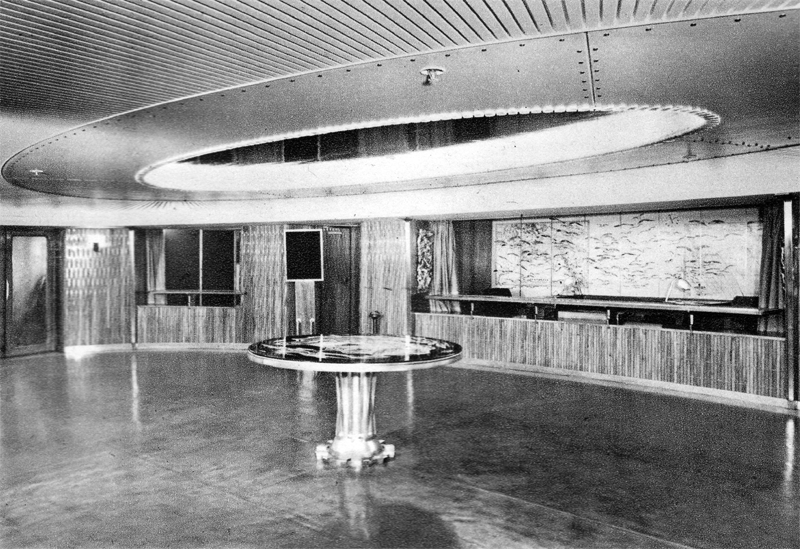
The
First Class Entrance Hall and Main Lobby with the Front Desk & Pursers
Office
We now come to A
Deck and there we find the stylish Main Lobby, the Front Deck, the Maitre
‘Hotel’s and the Chief Pursers office. There is also the ladies
Hairdresser on the starboard side. In the forward section there are nine First
class cabins that have private facilities, be it with a shower or a bath.
However, most cabins aft of the lobby have share facilities between two cabins.
Next we turn to the Second Class facilities:
Obviously
we will understand that all facilities are towards aft of the ship. On Promenade
Deck located atop of the Second Class Veranda Bar was the spacious Games
Deck that had facilities for a good variety of games, as well as sun baking for
those who decide they needed it when it was quiet up there!
Upper Deck
offered an excellent promenade deck for walking, but of course at the most
forward part is the Lido Terrace and swimming pool, directly followed by the
very popular Veranda Bar and lounge that was great inside as well as o the
terrace outside aft overlooking the stern!
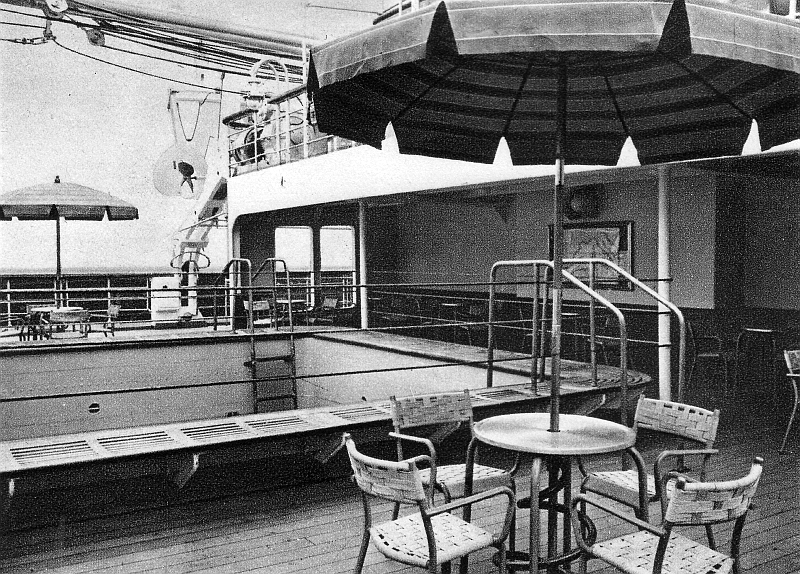
Lido
Bar and Pool
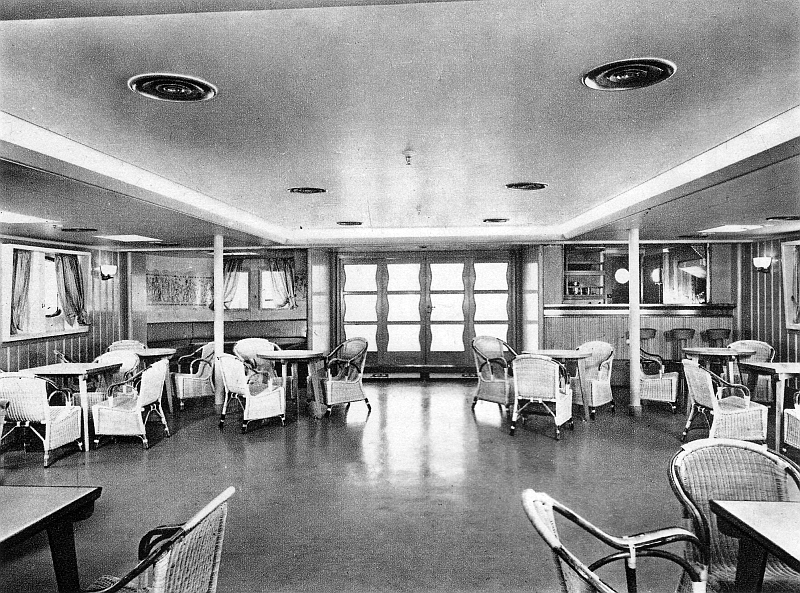
Veranda
Bar and Lounge
A
Deck offered one two berth cabin with private
facilities, and the rest were four berth cabins, that could be sold as two
three or four berths of course, but all of these had share bathroom between two
cabins. Aft of the accommodations was the very large Dining Room, which was
followed by the lobby, with the Writing Room of the port side and the children
Play Room starboard. Next is the spacious Second Class
Main lounge and the main venue for dancing and entertainment!
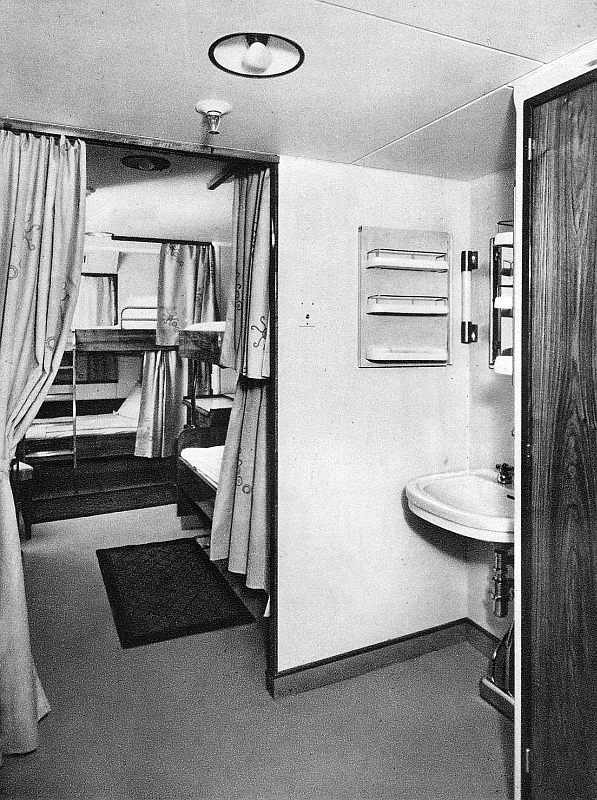
Here
we see a typical
four berth cabin with a shared bathroom that has a door into two cabins
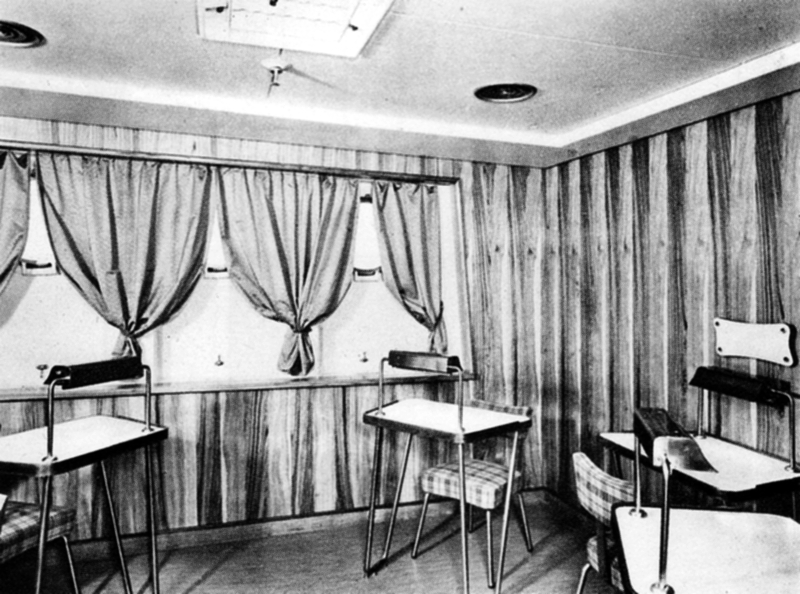
The
Writing Room
B
Deck has many cabins on the starboard side from two
to four berth and all having those shared facilities between the two cabins,
which seemed to be the thing on these ships, but obviously more economical and
making them more available to all passengers, rather than having to queue up in
those public bathrooms outside! On the port side there are just five cabins
aft, all four berth none having private facilities. Forward on port side there
was the ships surgery, doctor’s office, whilst aft near the main Second
Class Lobby was also the all important Emigration Office, as most people
travelling from Europe to Australia
would be migrants. At the Lobby, also being the entrance Hall was the Pursers Office and
the Hairdresser just aft. There were more cabins aft, including some very small
two berth cabins, the rest mostly four berth, but only a few with shared
facilities.
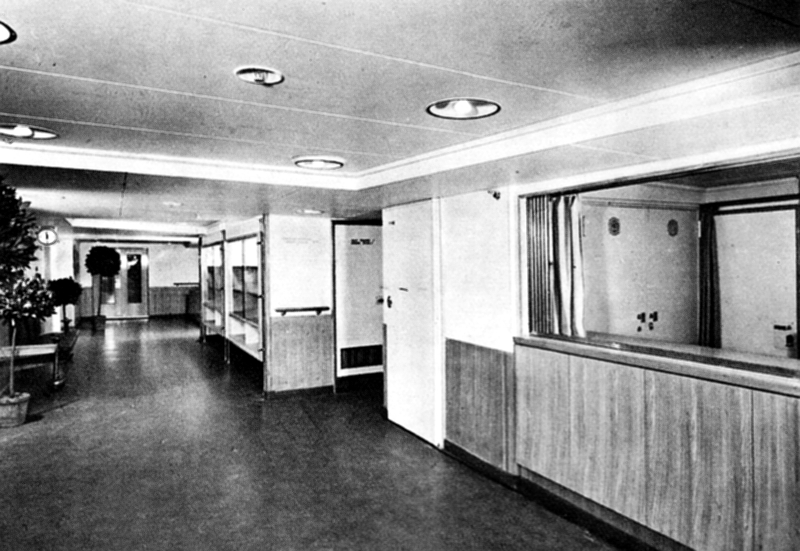
Main
Lobby and the Pursers Office
The
stairs down to the dormitories on Deck C are beside the passages forward and
aft.
Third
Class:
Passengers in this class would share the
overall facilities of Second Class that is the deck spaces and Lounges as well
as the Dining Room. The main difference being was their sleeping arrangements!
Deck C: Those
in Third Class would either need to use the down stairs located port and
starboard sides at the Second Class Main Lobby on B Deck, pending on which sex
you are either forward or aft of the lobby to reach the four main aft
compartments that contains a series of dormitories. However, others would need
to walk on the starboard side of B Deck as far forward as was possible to the
two down staircases, pending on their sex and head down to the very large
dormitories down on Deck C. All the dormitories had ample bathrooms and
WC’s available to them close by.
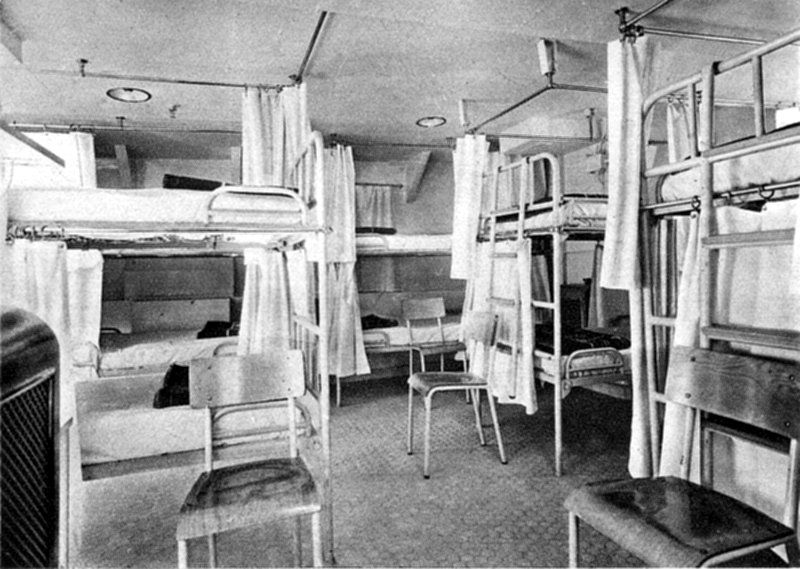
Here
we see a typical dormitory, yet this is one of the smaller ones
In 1956 with the
closure of the Suez Canal, the ships were rerouted via South Africa
until the Suez
was opened again in April 1957, great for the passengers and sightseeing, but
costly otherwise!
The 1958 Refit:
In
1958 the Australia
was returned to Italy
for an extensive refit and a partial rebuild, which saw her forward shelter
deck (A Deck) built in and there at hold number 2, a spacious new Tourist Class
lounge was installed. Changes were also made to the accommodations, as now she
would accommodate just 136 First Class, 304 Tourist Class A and 232
Tourist Class B.
The difference between Tourist A & B was
that passengers in Tourist A were accommodated in cabins, from two to four
berth, whilst those in Tourist B were accommodated in the various Dormitories
on C Deck aft and forward of the ship, just like Third Class used to be, but
now it had a name change and the dormitories had been reduced in size. Thus
considerable work was undertaken with her accommodations as well as a new
lounge! In addition the ship received a good freshen up and upon completion she
was 13,140 GRT.
There is a 1951 MS
Australia
Oceania
Neptunia Deck Plan available at the bottom of the page
Included
are sections of Deck Plans showing the new Tourist Class Lounge
located forward on A Deck
after 1958 as well as the changes on C Deck!
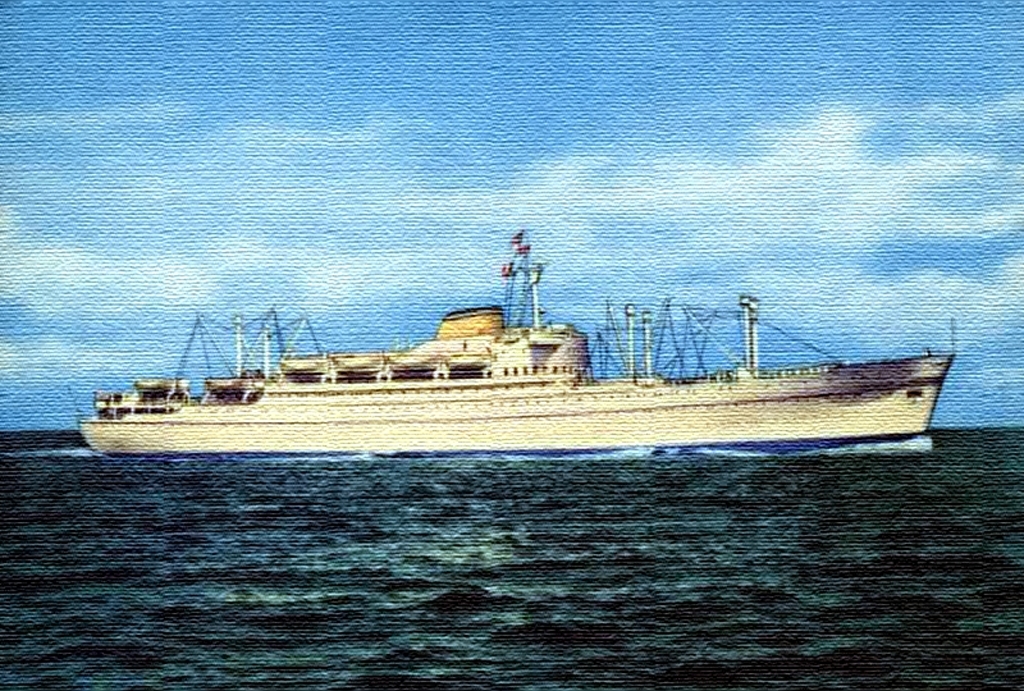
Above
we see an image of the Australia
after she had been refitted and rebuilt with her forward shelter (A) deck
having been filled in and a spacious and fine new Tourist Class Main Lounge was
added. See the plan below.
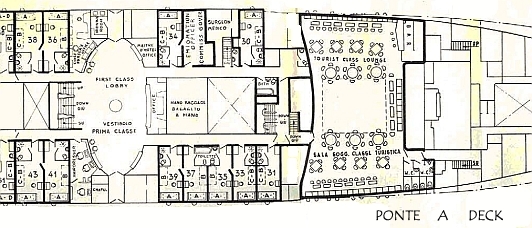
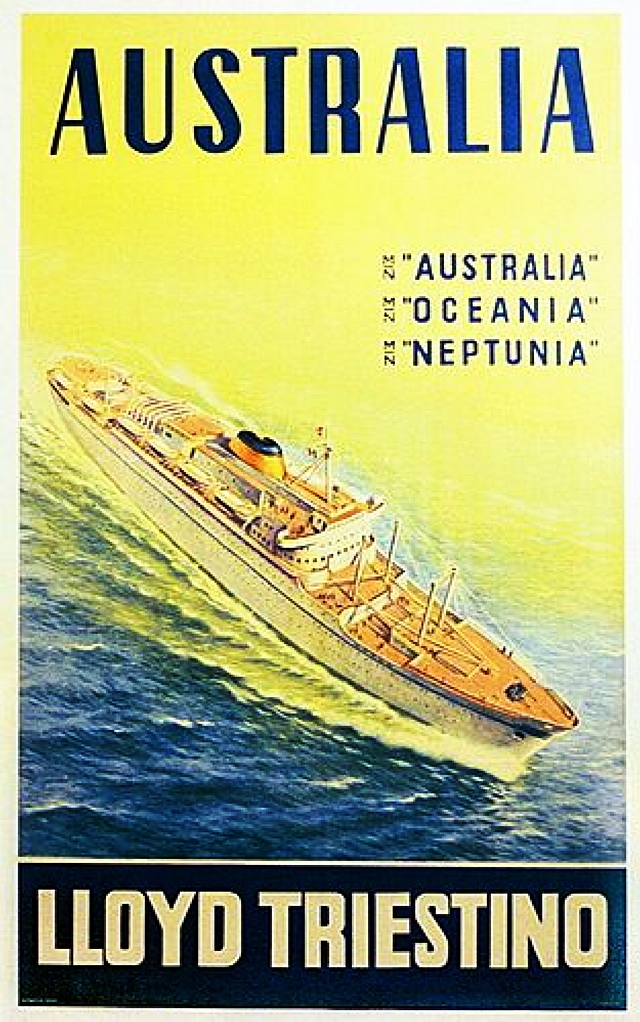
Advertising
the rebuilt and more “modern looking” Australia Class trio
As
is obvious from the above passenger numbers, First Class numbers had already
been dwindling, thus the increase in Tourist Class and the additional lounge
providing better facilities! Also, Lloyd
Triestino
was now marketing more and more to the younger tourist market, as well as to
families going home to Italy
and back, or families vesting their relatives in Australia,
etc. And most of these would travel in Tourist Class!
She continued sailing and proved
to be extremely popular with excellent loadings, which had Lloyd
Triestino
decide in 1960 to build two larger ships the Galileo and Marconi that would enter into
service in 1963, thus the time for the Australia
trio would end.
The wonderful MS Australia was the very first
to be withdrawn from her Australian duties as she departed Genoa
for her very last voyage on January 18, 1963. Having arrived at Sydney,
she made a sad farewell as she departed on February 21 and many came to wave
her off. On her way home to Italy
she called on the following Australian ports; Hobart
on February 23, then Melbourne,
Adelaide
and Fremantle from where she departed Australia
for the very last time on March 4 for Genoa!
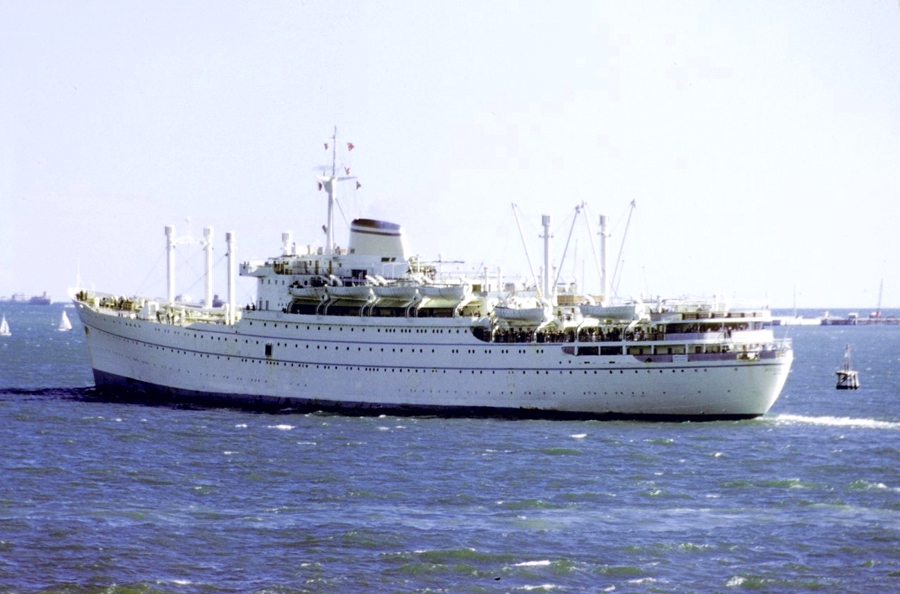
MS
Australia departs Melbourne
for the final time in 1963 bound for Genoa
to become the Italia Line’s MS Donizetti
Photograph by Peter
Plowman – from
the Rich
Turnwald
collection
A New Name and Service:
Upon
arrival in Genoa
and having unloaded, she was handed over to the Italia Line who renamed her Donizetti. She was given
yet another refit and made ready for her new role operating the companies Genoa
to Central America
service. Upon completion she was register as being 13,226 GRT. MS Donizetti
departed Genoa
for her first voyage to Valparaiso
on June 4, 1963. This service continued for a good thirteen years, however,
like as with all passengers services air travel was making inroads as the Boeing
747 introduced cheaper fares and obviously speed, but another major factor was
the introduction of containerisation, on these ships were simply not suited as
modern cargo ships anymore, thus 1976 would see her sail on her final voyage
ever!
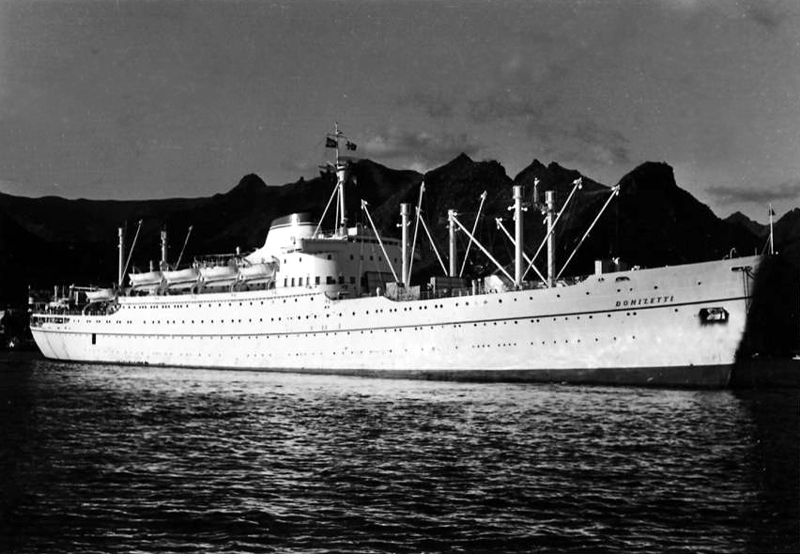
Here
we see the Italia Line ship, the MS Donizetti, ex Australia
Thus tragically, in July1976, the
beautiful MS Donizetti, ex Australia
was withdrawn from service and she was first of the trio to be laid up at Genoa.
She was later moved to La Spezia.
Then, on July 4, 1977 she was moved to “Cantieri
Navali
del Golfo”
at La Spezia
where she breaking up commenced immediately. She would soon be
followed by her sisters!
********************************************
Part
Three – MS Oceania:
Like
the Australia,
the Oceania the second of the series, was also built by the Cantieri
Reuniti dell’Adriatico Shipyards in Trieste,
but in Yard number 1759. She was launched on July 30, 1950 and completed and
delivered to Lloyd
Triestino
in August 1951.
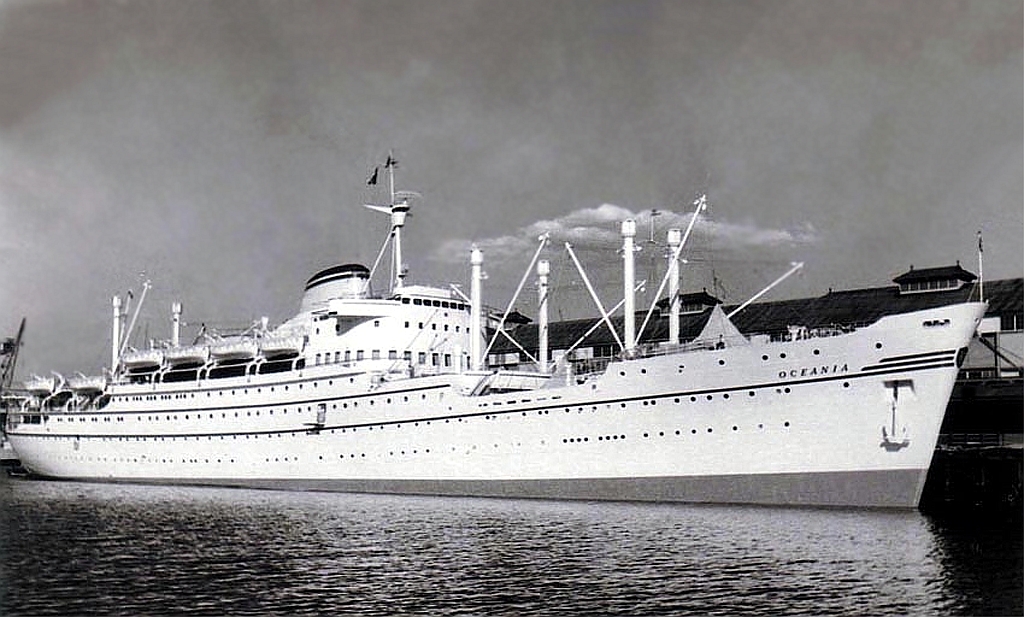
MS
Oceania see as built with her shelter deck still open, which was used as a
Third Class Promenade Deck having a Bar there as
seen on the deck plan
Photographer unknown –
*Please see the photo notes at the bottom of the page
She departed on her maiden voyage
from Genoa
on August 18, 1951 and headed via the same route as shown above in the MS
Australia section. Like her sister she was very popular and was usually fully
booked.
MS Oceania Photo Album:
First
Class
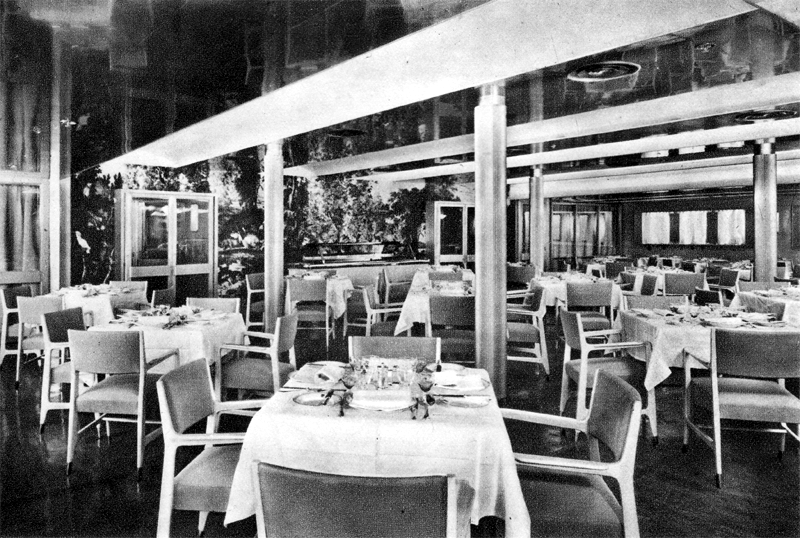
The
Restaurant
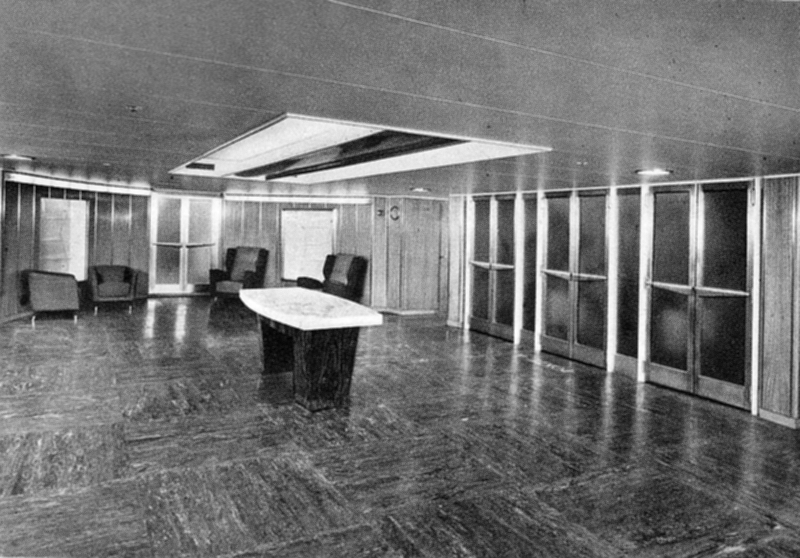
Main
Lobby and entrance to the ship
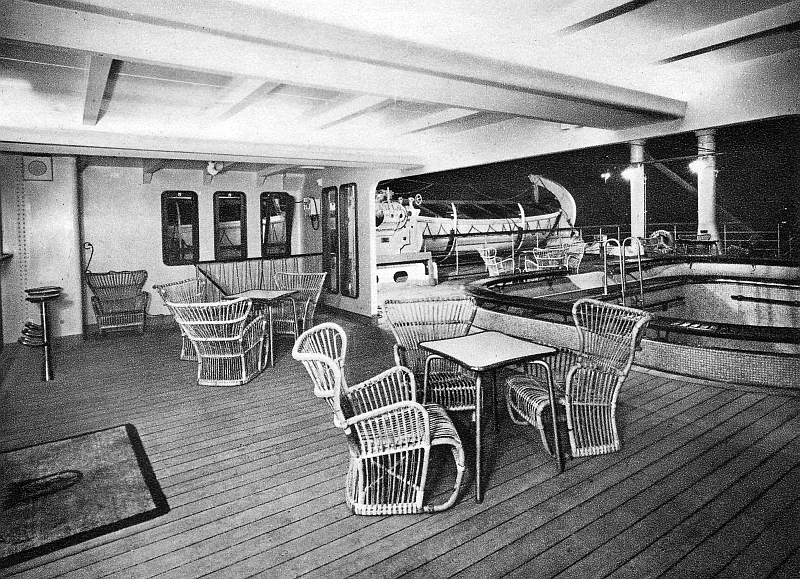
Lido
Bar and Pool
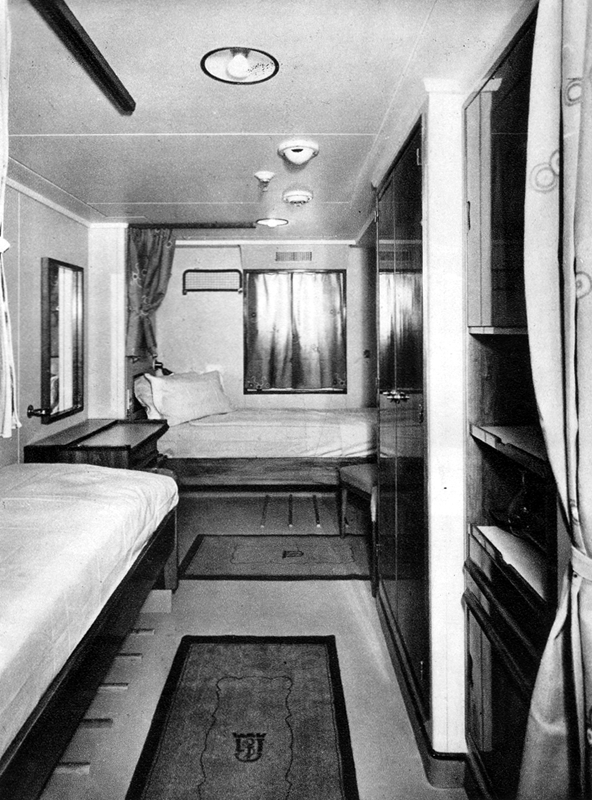
Typical
twin bedded cabin, the bed at the end converts to a settee
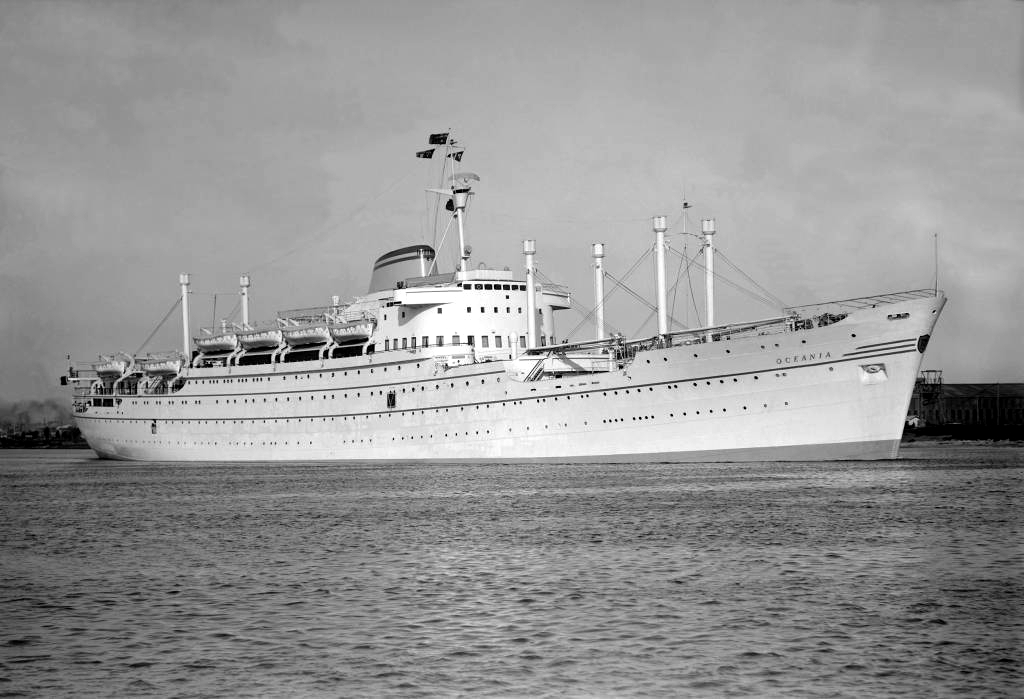
MS
Oceania seen arriving in Melbourne
in 1951
Second
Class
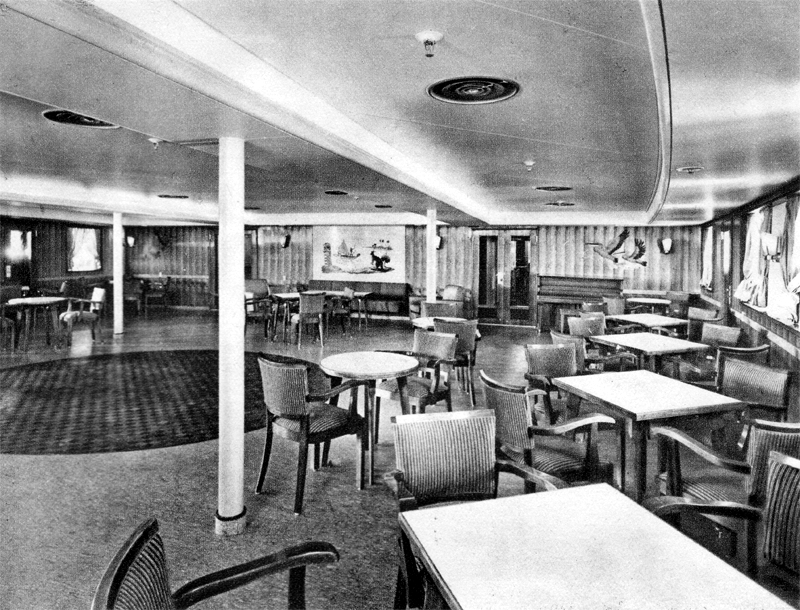
Here
we see the Main Lounge which was reasonably
similar on all ships
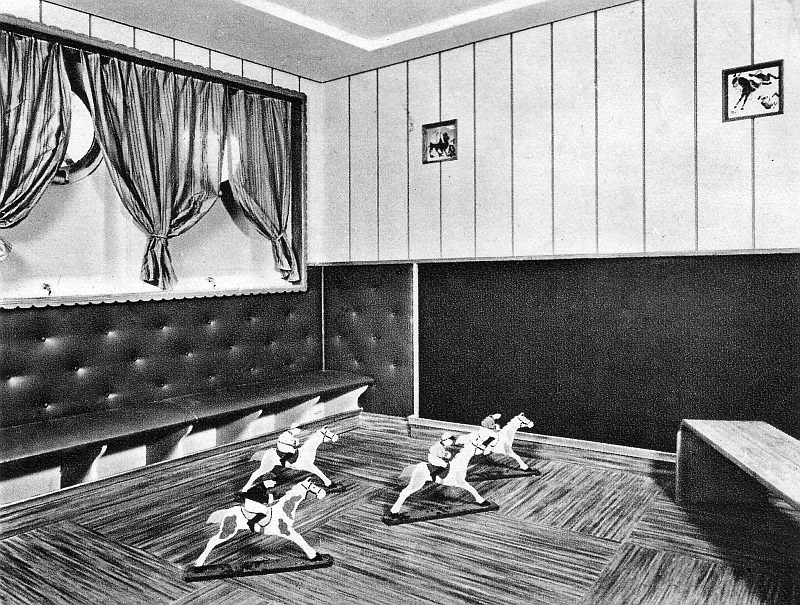
Children’s
Play Room

A
four berth cabin
In
1956 with the closure of the Suez Canal, the ships were rerouted via South Africa
until the Suez
was opened again in April 1957, great for the passengers and sightseeing, but
costly otherwise!
The 1958 Refit:
In
1958 the Australia
was returned to Italy
for an extensive refit and a partial rebuild, which saw her forward shelter
deck (A Deck) built in and there at hold number 2, a spacious new Tourist Class
lounge was installed. Changes were also made to the accommodations, as now she
would accommodate just 136 First Class, 304 Tourist Class A and 232
Tourist Class B.
The difference between Tourist A & B was
that passengers in Tourist A were accommodated in cabins, from two to four
berth, whilst those in Tourist B were accommodated in the various Dormitories
on C Deck aft and forward of the ship, just like Third Class used to be, but
now it had a name change and the dormitories had been reduced in size. Thus
considerable work was undertaken with her accommodations as well as a new
lounge! In addition the ship received a good freshen up and upon completion she
was 13,140 GRT.
There
is a 1951 MS Australia
Oceania
Neptunia Deck Plan available at the bottom of the page
Included
are sections of Deck Plans showing the new Tourist Class Lounge
located forward on A Deck
after 1958 as well as the changes on C Deck!
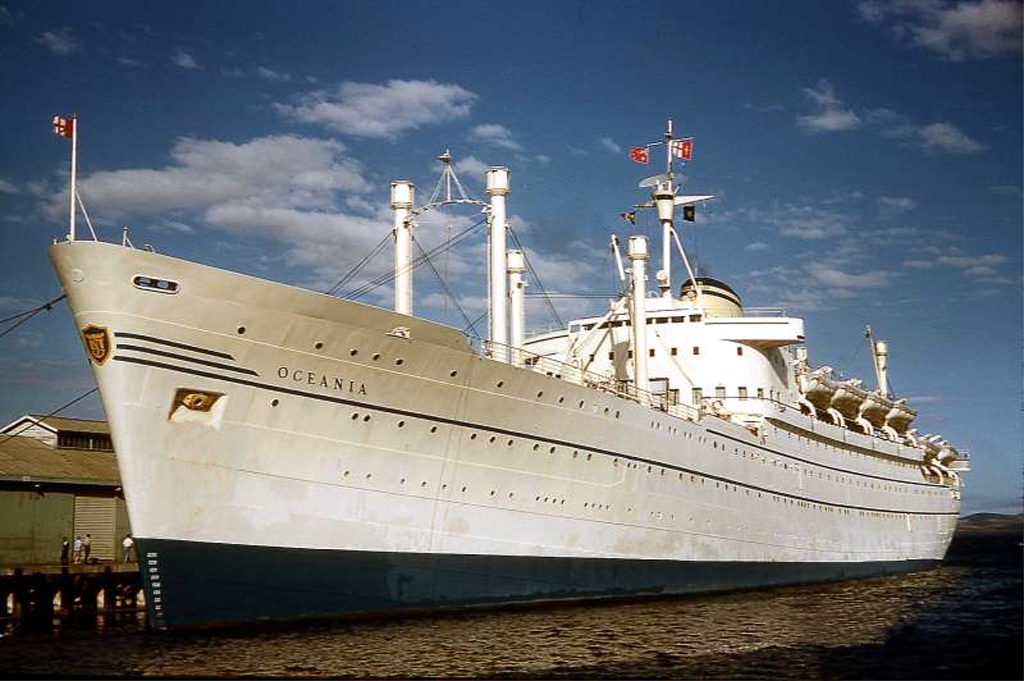
The
refitted and rebuilt Oceania
– Note the 8 small portholes under the forward Kingposts
You
will note that there are a series of four twin portholes located in the upper
hull, being the new lounge
Photographer unknown –
*Please see the photo notes at the bottom of the page
She returned and her tourist class proved to
be very successful and business was very good for a while, but the modern age
caught up with the Jet age as well as containerisation and slowly Lloyd
Triestino
knew it was time to remove her from the very long services!
A New Name and Service:
MS
Oceania departed Genoa
for her last voyage to Sydney
on February 15, 1963, arriving there on March 23. Upon her return to Italia,
like her sister Australia
before her to operate the Genoa,
Central South America
services. Thus she was handed over to Italia Line and was renamed; Verdi. With the MS Verdi having received
a refit and other minor alterations she was registered at 13,226 GRT
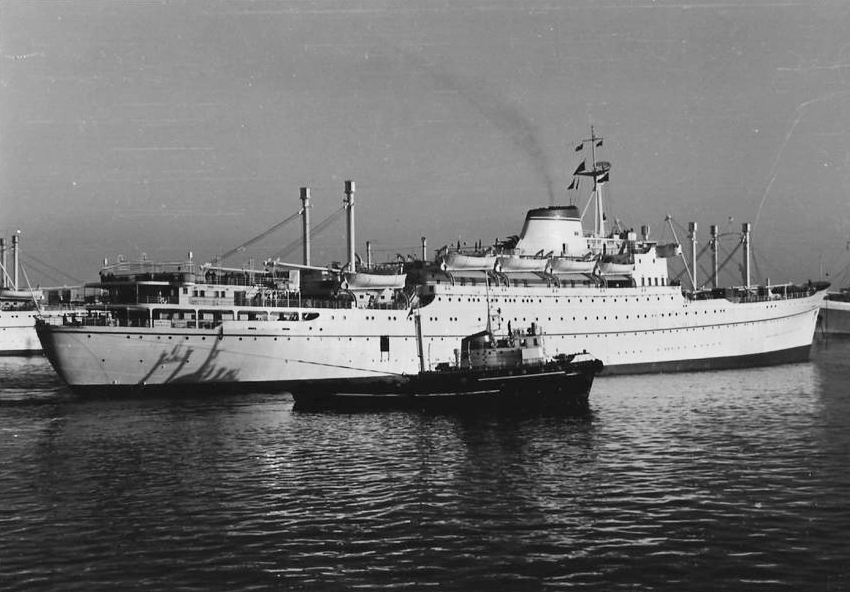
Here
we see the MS Verdi, ex Oceania
Photographer
unknown – *Please see the photo notes at the bottom of the page
However,
just within a few months this fine ship encountered her very first ever
accident since 1951. It would be on April 16, 1964, when the Verdi collided with another ship
in fog not far from Gibraltar.
The other ship was a tanker named the Pentelikon. MS
Verdi suffered damage to her bow and thus she had to return to Genoa
for repairs.
The Verdi returned to her Genoa
to Central South America services and continued this service successfully until
July 1976, when she was withdrawn from service and laid up at Genoa.
Then on June 23, 1977 she arrived at the “Cantieri
Navali
del Golfo”
yard at La Spezia
where she was duly broken up.
********************************************
Part
Four – MS Neptunia:
MS
Neptunia the third and last ship of the trio to be built by Cantieri
Reuniti dell’Adriatico Shipyards at Trieste,
Italy
at Yard 1760, and she was launched on October 1, 1950.
She was completed in September 1951. The gleaming white Neptunia completed was
ready for her maiden voyage with a full complement on September 14, 1951, as
she headed for Sydney
Australia
and completed her journey in Brisbane
on October18. With the Neptunia having commenced in service Lloyd Triestino
finally had three fine fast liners in service transporting passengers as well
as cargo, and better still, loadings were even better than was expected! This
continued for the next decade and the company was happy with its profitability!
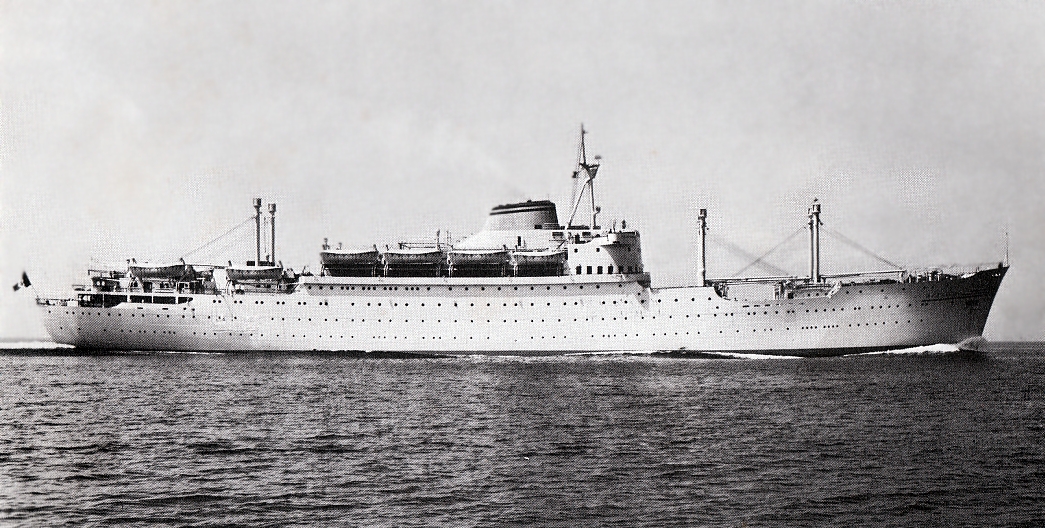
Here
we see the Neptunia in her early days with her shelter deck still in place,
that would later be built in to become a lounge
MS Neptunia Photo Album:
First
Class
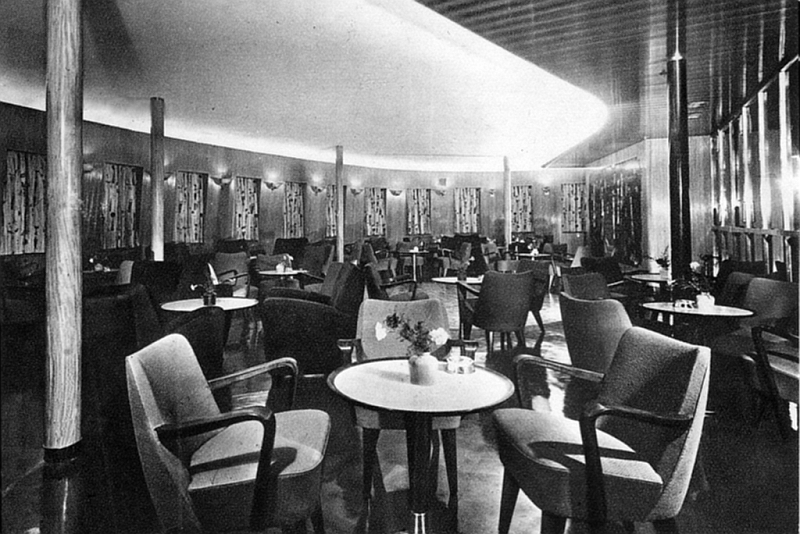
The
Main Lounge and Bar - forward on Promenade Deck
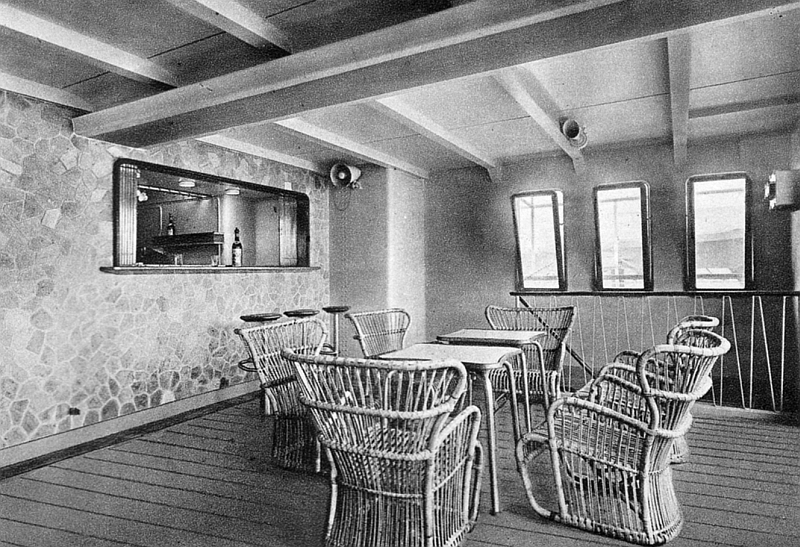
The
Veranda Bar forward of the Pool – aft on Sun Deck
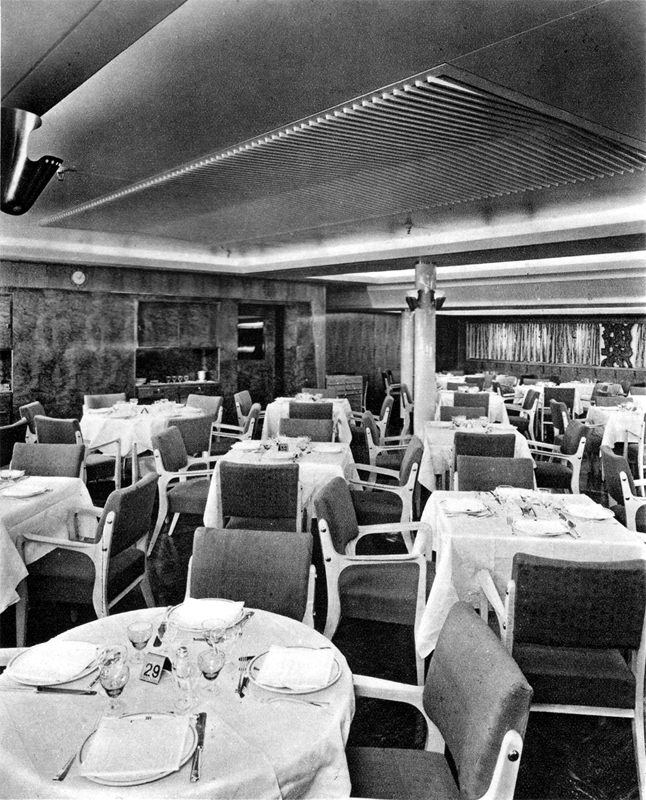
The
most attractive Dining Room - aft of First Class on Upper Deck
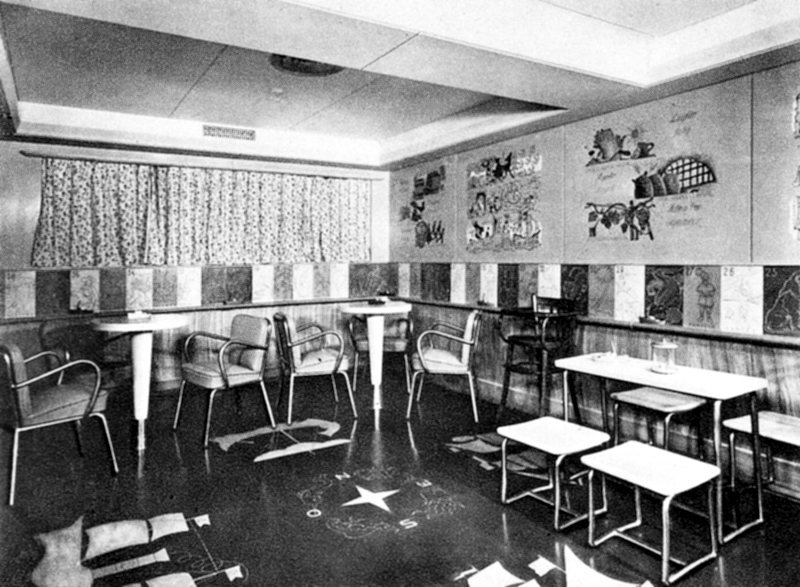
Children’s
Play Room – forward on Sun Deck
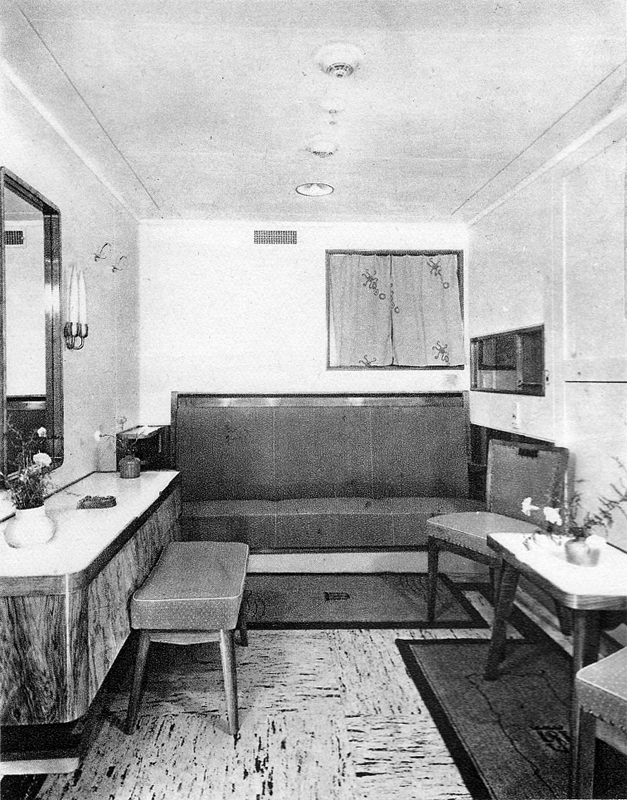
A
single or two bed cabin, the settee converts to a bed
and the other bed folds down from the wall
See
the next photograph!
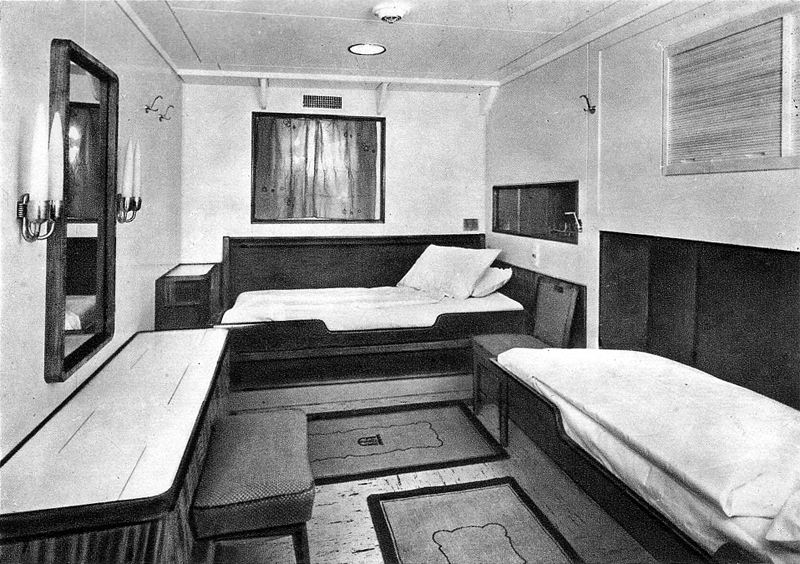
This
is a similar cabin to the above
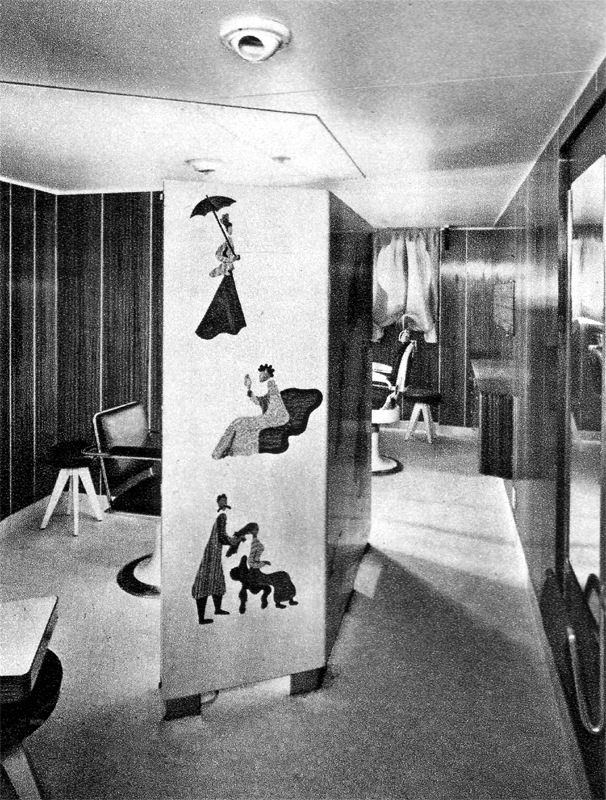
The
Ladies hairdresser – near the Main Lobby
In
1956 with the closure of the Suez Canal, she was rerouted via South Africa
until the Suez
was opened again in April 1957.
The 1958 Refit:
In
1958 the Neptunia was returned to Italy
for an extensive refit and a partial rebuild, which saw her forward shelter
deck (A Deck) built in and there at hold number 2, a spacious new Tourist Class
lounge was installed. Changes were also made to the accommodations, as now she
would accommodate just 136 First Class, 304 Tourist Class A and 232
Tourist Class B.
Like on the other two ships, the difference
between Tourist A & B was that passengers in Tourist A were accommodated in
cabins, from two to four berth, whilst those in Tourist B were accommodated in
the various Dormitories on C Deck aft and forward of the ship, just like Third
Class used to be, but now it had a name change and the dormitories had been
reduced in size. Thus considerable work was undertaken with her accommodations
as well as a new lounge! In addition the ship received a good freshen up and
upon completion she was 13,141 GRT
There
is a 1951 MS Australia
Oceania
Neptunia Deck Plan available at the bottom of the page
Included
are sections of Deck Plans showing the new Tourist Class Lounge
located forward on A Deck
after 1958 as well as the changes on C Deck!
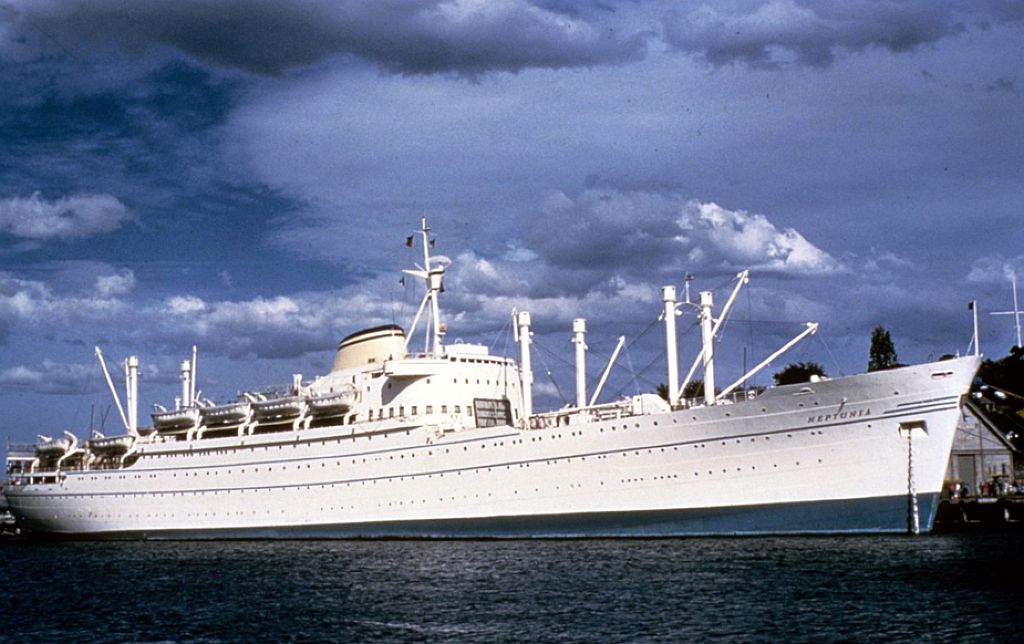
The
Neptunia certainly looked an absolute delight when she was completed!
Note
the five sets of double portholes located forward of the superstructure where
the shelter deck used to be
Photograph
by Ted Scull from the Rich
Turnwald
collection
As she retuned to service like
her sisters her passenger numbers improved greatly and she was a great success
once again, but as time passed, she like every other passenger liner in the
world and she was hit by the very same problems, being airlines, and if a liner
was also reliant on carrying cargo, the container trade had taken over the vast
majority of the work, thus holds combined with kingposts and derricks were out
of date! And the Neptunia could neither fly nor carry containers, thus she
needed another job!
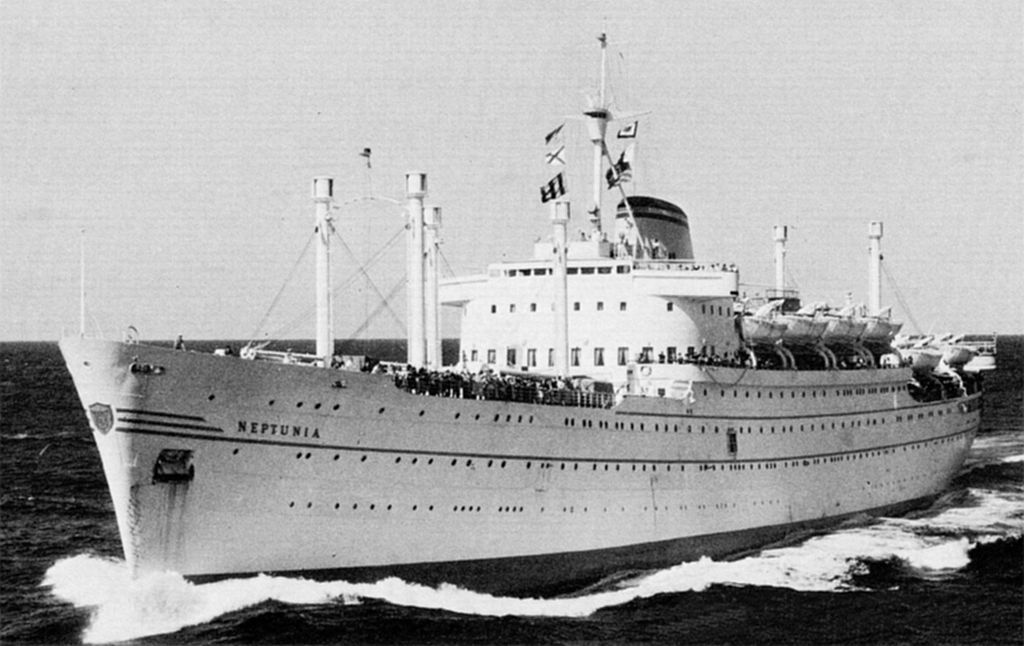
Neptunia
is seen during her last days as a Lloyd
Triestino
ship
It was in April 1963 that the first of the
brand new large and grand Lloyd
Triestino
liners entered service, being the excellent Galileo
Galilei,
whilst her sister the Marconi had been delayed. This
was good for the Neptunia as this extended her service for a just little longer
on the Australia
service and she sailed on until her last departure fro Genoa
on August 1, 1963, bound for Sydney
where she departed on September 11.
A New Name and Service:
Upon
her return to Genoa,
just like the Australia,
she was also transferred to the Italia Line to operate the Genoa
to Central America
service and they renamed her; Rossini, then she received a
refit, achieving a tonnage of 13,225 GRT, and commenced on her new service.
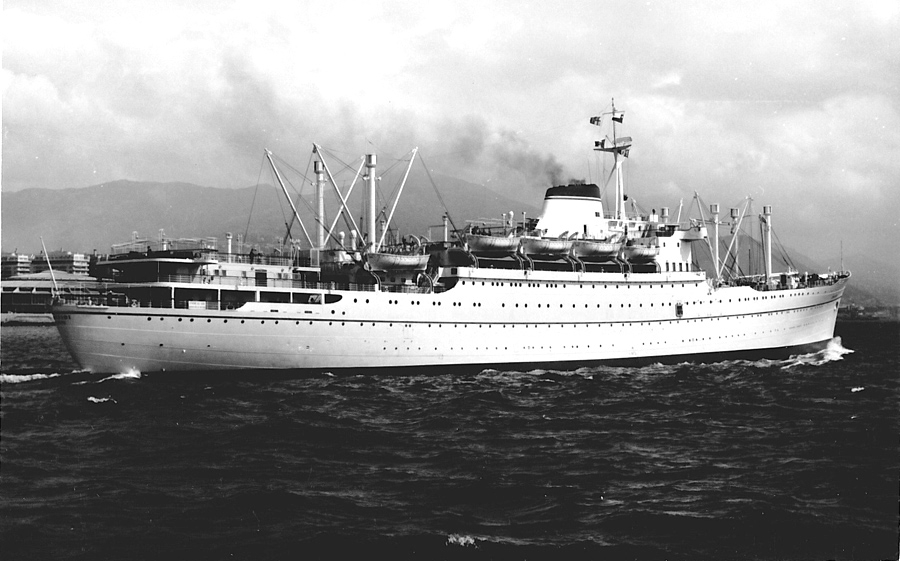
The
Italia Line MS Rossini sets sail
However the Rossini, just like the Verdi and Donizetti would all become
obsolete and were to be withdrawn from service. Both the Donizetti and the Verdi were the first to be laid
up at Genoa
in July 1976; they were followed by the Rossini just a month later in
August 1976.
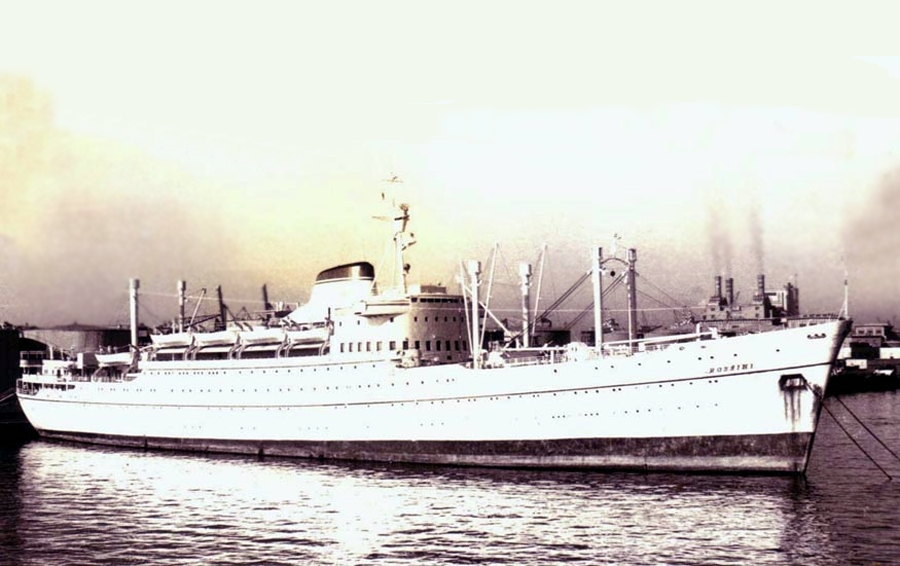
A
photograph of the MS Rossini seen laid up and close to
her final days!
Photographer
unknown – *Please see the photo notes at the bottom of the page
Having
been laid up at Genoa, but on June 23, 1977 the MS Rossini the superb ex
Neptunia arrived together with her sister the Verdi at the “Cantieri Navali del Golfo” yards at La Spezia where breaking up commenced
without delay! Strangely enough it was the first of the trio to be built just
happened to be the last to arrive at the breakers yard, some twelve days later
on July 4, 1977. It was the end of a great era of shipping, as from here the
new great and big liners took over, but even they would become out dated fairly
rapidly as passengers shipping fell into decline.
But then suddenly the cruise
industry recommenced the greatest resurgence in shipping and today there ate
more passenger ships at sea today, with a greater number of berths on the water
in one day, than there has been throughout every generation counting back from
the 1980s! However, some of the new ships are far from being attractive to look
at, they are more like big square apartment (Condo’s) blocks, and inside,
more like shopping malls, with countless optional dinning venues and hard sell
wherever you go! For me that is not a leisurely cruise vacation, but that is
the American influence of the modern world! Yet, there are still fine cruise
lines around and as the author is also a cruise and a ship reviewer and still
continues this on www.cruise-australia.com,
you can always contact me for advise for the best available, and be assured, I
am a non profit website and sell nothing!
********************************************
What
can we say about such delightful ships? I do know that I continue to receive
many emails from people who have sailed on them, and they ask me, “But
Mr. Goossens, why have you never written on these three important ships, you
cover so many of the ships that have called on Australia and New Zealand, but
somehow you have missed the ship that brought me and my family to this county,
which was the best thing that ever happened in my whole life. The ship I
remember still, although I was young, but she was so beautiful and we had a
very good time. Because we sailed via South Africa,
we did have some rough waters, but our family did not mind, being fisher people
back home! … etc”
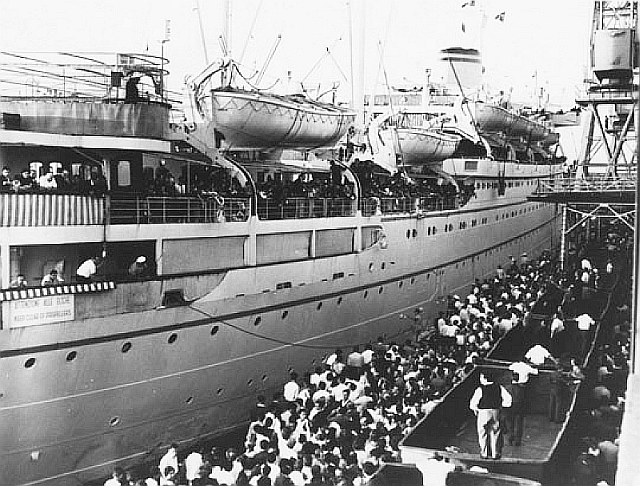
Memories
of the MS Australia departing Melbourne
for Genoa
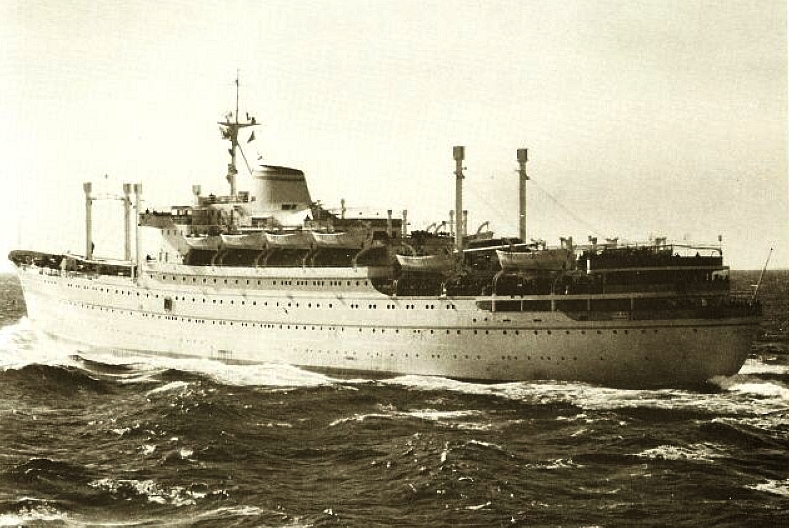
MS
Australia, Oceania
and Neptunia may have sailed into the sunset, but they will remain in our
memories!
Although I retired quite some time ago and I
did clearly state some time back that I would not write any further features,
well I obviously did write on a few more ships occasionally when I was able,
for I had a great desire to include this trio of ships, which were so important
to the wonderful fleet of ships that served Australia, and I trust that you
have enjoyed this feature and the deck plan on the next page.
Best wishes, Reuben Goossens.
Ships Specifications:
Built
at: Cantieri
Reuniti dell’Adriatico Shipyards, Trieste,
Italy.
Yards: Ship
- 1. 1758 – 2. 1759 – 3. 1760.
Tonnage 1951: 1.
& 2. 12,839 GRT – 3.
12,838 GRT.
Tonnage
- 1959: 1. 13,226 GRT – 2. 13,226 GRT –
3. 13,225 GRT.
Length: 160.9m /
528ft.
Breath: 21.1m
/ 69.2ft.
Draught: 8.16m
/ 26.8ft.
Engines: Sulzer Type Diesels by the builder - 14,000 BHP.
Screws: Two.
Speed: 18
knots.
Passengers as built: 280 First Class. 120
Second Class. 392 Third class.
Passengers - 1959: 136 First Class. 536 Tourist Class – 304 Tourist A & 232 Tourist B.
Crew: 236.
View the 1951 MS Australia Oceania
Neptunia Deck Plan
Included
there are sections of Deck Plans showing the new Tourist Class Lounge located
forward on A Deck after 1958
As
well as the changes on C Deck, as dormitories were reduced in size and in one
case a whole section was changed to just cabins.
Other Lloyd Triestino ships on ssMaritime:
TN Galileo & Marconi
- MV Africa & Europa
& SS Toscana
Return to the ssMaritime MAIN INDEX
Featuring over 1,250
Classic Passenger Liners, Passenger-Cargo Liners & humble Migrant Ships
from around the Globe
ssMaritime.com & ssMaritime.net
Where
the ships of the past make history & the
1914 built MV Doulos Story
Also visit the …
“Save The
Classic Liners Campaign”
Please Note: ssmaritime
and associated sites are 100% non-commercial and the author seeks
no funding or favours of any shape or form, never have and never will!
Photographs on ssmaritime and associate
pages are by the author or from the
author’s private collection. In addition there are some images that have
been provided by Shipping Companies and private photographers or collectors.
Credit is given to all contributors. However, there are some photographs
provided to me without details regarding the photographer/owner concerned. I
hereby invite if owners of these images would be so kind to make them-selves
known to me (my email address may be found on www.ssmaritime.com
only), in order that due credit may be given.
This notice covers all pages,
although, and I have done my best to ensure that all photographs are duly
credited and that this notice is displaced on each page, that is, when a page
is updated!
ssMaritime is owned & © Copyright by Reuben
Goossens
- All Rights Reserved













































